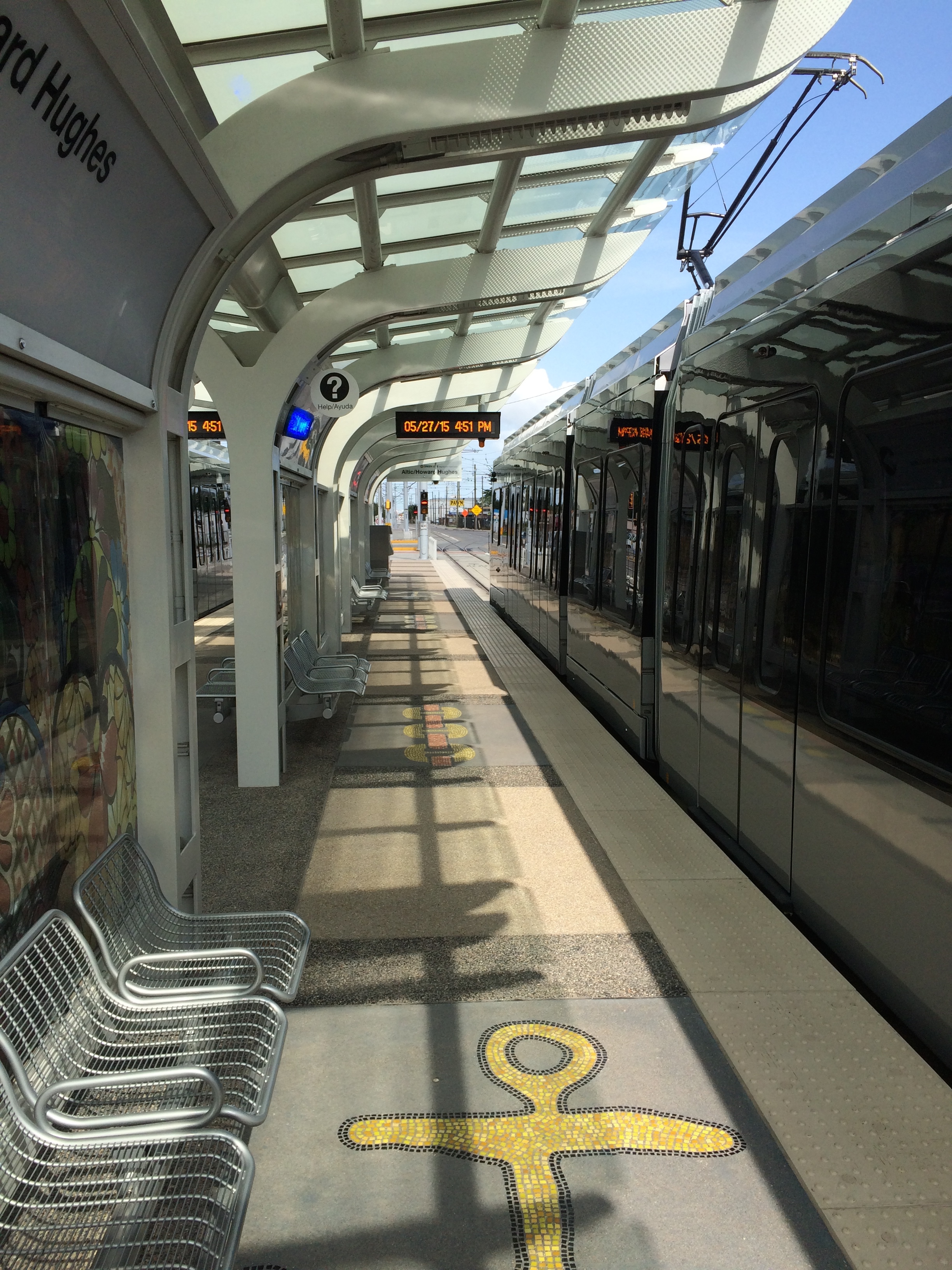The skateboarder just couldn’t keep up.
He flew down the hill that takes Harrisburg Boulevard underneath the freight railroad tracks. But the newly opened Green Line light rail train pulled away from him faster and faster.
A group of Metro fare inspectors told me he’d bet them he could beat the train to the next stop (they didn’t take him up on his wager). I didn’t see him crest the hill before the train pulled away from the Coffee Plant stop. Next time, maybe he’ll take the rail.
I asked the inspectors what they thought of the new rail lines, which opened on Memorial Day weekend. The question wasn’t much of a distraction. After the Lockwood stop, I was the only rider on the afternoon outbound train during a ride I took last week, just days after the rail line opened.

GoMetro.org
One was excited about how the newly opened Green and Purple lines opened up parts of Houston that many residents had never visited. She highlighted the lines’ proximity to good local restaurants like Frenchy’s Chicken in the Third Ward or Champ Burger in the East End. I’ve already scheduled a lunchtime ride to visit both.
The riders I spoke with on the Green Line, though, were not aboard for food. Many were already using the line to get to and from work. They were happy with the frequent arrival of trains, which made travel quicker than when they had to wait on infrequently running buses. The Green Line runs a train every 10-12 minutes, faster than most local buses (at least until the new reimagined bus line comes online in August).
Jim, a security guard for an East End company, said he was headed to work. Given the disruptive storms that battered Houston earlier in the week, he was riding the line for the first time. He commutes to the East End daily from the Beechnut/Gessner area in southwest Houston. Prior to the Green Line opening, he took the 4 bus to the TMC transfer station, got onto the Red Line light rail, then transferred again to the 50 bus for his ride out to the East End. Jim, who lacks a car, estimated his normal commute at about 2 hours.
Switching the last leg of his journey from the bus to the new Green Line will cut his trip by at least half an hour, he said.
Erica, who has lived in Houston her entire life, shaved 20 minutes from her daily commute by shifting from the bus to the train. She hopes the transit agency continues to expand its efforts. “METRO should do whatever they could to help other riders save time,” she said.
While some riders seem content with the new line, other residents and business owners remain frustrated with the project. Mark Rodriguez, owner of Gulf Coast Used Cars on Harrisburg has long been a vocal critic of what he sees as METRO’s lack of communication with and support for business owners along the line. He also serves as president of the Oaklawn/Fullerton Civic Association, a community within the East End.
Rodriguez pointed to delays in construction of the Green Line, which was originally slated to take three years but will now take eight with the pending construction of an overpass at the Union Pacific tracks. The original timeline was bearable, Rodriguez said, but the extended construction and delay were crippling for businesses like his that depended on customers using Harrisburg Boulevard. When I asked whether he had participated in METRO’s business assistance fund, which compensated business owners affected by construction, he said yes. But he considered the $25,000 he received to be a paltry sum (he worked it out to about $8 per day during construction).
Rodriguez is skeptical he’ll get any more support, and he doesn’t think he’ll get much benefit from the new line either. “Maybe I’ll take the train to the rodeo or some other event once or twice a year,” he said.
On my inbound trip back to downtown around 5:15 p.m., I spoke with Steven Vargas, who works in the East End but lives in the Montrose area. Vargas, a longtime Houstonian, has made a very un-Houstonian choice about his transportation for more than a decade. He doesn’t own a car. And it’s not because he can’t afford one. He just prefers to live without it.
Vargas either walks, buses, bikes, or car-shares to meet his daily travel needs. As with the other riders, Vargas’ commute should be shortened by the new line. Our ride was Vargas’ first, and he was closely timing it. Before the line opened, his journey (which involved a bus trip, a hop onto the Red Line, and then another bus) could take as long as an hour and 20 minutes. Changing to a bus-to-rail-to-rail, he thought, would cut that time considerably.
Vargas said that he hopes the new light rail lines would be the “germination of a transit system,” one that grew to serve more and more of the city effectively.
Infrastructure construction is a long process. And for those who live and work in close proximity to routes, the process can be arduous and disruptive. Mitigating those concerns should be a goal of any public agency – and it’s one METRO has pursued for decades. Clearly, the agency and the community have more to work out, but with the train running, perhaps positive outcomes will start to rack up as well.
While some thorns remain, the Green Line is blooming in the East End. Stop to smell the flowers (and coffee) the next time you ride.

